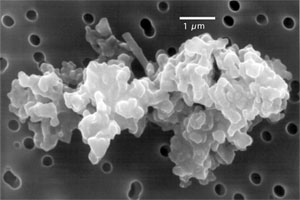About Space Dust
Origins of Dust

A scanning electron microscope image of an interplanetary dust particle. (Courtesy E.K. Jessberger, Institut für Planetologie, and Don Brownlee, University of Washington)
Dust in space gives scientists clues to processes throughout the solar system and the galaxy. Dust grains are generated by several processes, including mutual collisions between asteroids or Kuiper-Belt objects, hypervelocity impacts on airless bodies, such as the Earth’s moon or the Galilean moons, and other, more exotic processes, such as the volcanoes on Jupiter’s moon Io or the hydrothermal vents on Saturn’s moon Enceladus. Studying these grains can give scientists clues about how the solar system was formed billions of years ago and how the solar system works today.
Importance of Dust
The universe slowly recycles dust, moving it from one location to another. A dying star will send dust out into interstellar space. This dust can then collect with gas into clouds that slowly cool and become denser. Eventually, these clouds of gas and dust contract to form new stars and planets, and the cycle begins again.
Since dust is found throughout the galaxy in numerous environments, it contains information about a vast quantity of sources. By studying the dust in our own solar system, we can learn about planets, moons, and comets in our own planetary system as well as about stars and nebulae much farther away. We can also learn about the processes that affect dust as it travels throughout space.
So why care? Because we are surrounded by the ashes of dead stars, and by studying these ashes we can learn a lot about the universe that surrounds us.






